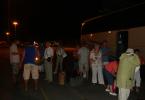1.Take VISA cards with you , since there are NOT MANY banks and ALL ATMs service ONLY VISA cards. Having a MASTER CARD system card in your pocket, of course, you will NOT get lost, but you will face additional difficulties in withdrawing cash.
Firstly, you will be able to withdraw money only during the day on weekdays (excluding Saturday and Sunday) during business hours (usually from 9-00 to 16-00) at METROPOLITANO Bank branches. At the same time, there are not many of these branches and NOT ALL branches have the ability to withdraw cash from MASTER CARD system cards. When visiting the bank, do not forget to have your PASSPORT with you and be patient, as the queues can be VERY LARGE (when Cubans withdraw their salaries there, it is not a problem to stand there for an hour or two).
Secondly, you can withdraw money during the day on weekdays (excluding Sundays) during business hours (usually from 9-00 to 17-00 or sometimes until 19-00) at branches of the CADECA state exchange offices system. At the same time, there are also NOT MANY branches and NOT ALL branches have the opportunity to withdraw cash from cards of the MASTER CARD system. You can EXACTLY do this in the CADECA Branch of the NACIONAL Hotel (main entrance, then left and again left down the stairs to the ground floor, then left again to the cafe and right through the door at the entrance to the Hotel pool), or in the Central Branch CADECA on 23rd Street in the VEDADO area next to the HABANA LIBRE Hotel, which is open until 19-00. Don’t forget to also have your PASSPORT with you and be patient, as the queues can be LARGE at the CADECA Central Branch, and at other branches you’ll be lucky.

2. Take cash with you in EURO currency , because due to long-standing strained political relations with the United States and the economic embargo, the Cuban Government in all currency exchange offices of banks charges an additional fee to the treasury in the amount of 10% of the transaction amount when exchanging the US dollar for the Cuban Convertible Peso (CUC).
3. Change currency at ANY branch of METROPOLITANO Bank or some branches of the CADECA system of state exchange offices. You can DEFINITELY exchange money at the CADECA Branch in the NACIONAL Hotel, or at the CADECA Central Branch on 23rd Street in the VEDADO area next to the HABANA LIBRE Hotel. Upon arrival in Havana, you can (even you will NEED, we recommend) change the required amount of money for travel expenses at the Bank Branch in the airport lobby upon exit (there are two identical currency exchange offices - to the RIGHT of the EXIT DOORS and to the LEFT of them, choose ANY) . The currency exchange rate IS THE SAME ALL OVER CUBA, as it is set by the state, so change BOLDLY as much money at once as you may need for the WHOLE trip, so that later you DON’T have to LOOK for other currency exchange offices and DON’T stand in queues again.

4. In Cuba, there are officially TWO national currencies in use: the Cuban Convertible Peso (CUC) and the National Cuban Peso (CUR). The difference between them for tourists is that 1 CUC costs 24 CUR when it is sold, and when exchanging EUROs you are given EXACTLY CUC and all prices USUALLY for foreigners in Hotels and good restaurants are set in CUC, and the difference between currencies for Cuban citizens is that , that they receive their salary ONLY in CUR, and in order to buy something in special stores where goods are sold ONLY for Convertible Peso, they need to BUY this CUC at a price of 25 CUR for 1 CUC.
HERE lies the most COMMON trick-DECEPTION for tourists who walk “by themselves” around Cuba and DO NOT KNOW in what currency the price is set on the menu in a cafe, or on the price tag in a store. Usually in MANY shops and cafes prices are indicated in CUR, and tourists are told that this is CUC. Therefore, you OVERPAY 24 TIMES (!!!) for these goods and services, and this “sweet” difference goes straight into the pockets of the deceivers, and then, returning to Russia, you are surprised to tell your friends “HOW EXPENSIVE EVERYTHING IS IN CUBA!”
Here prices are indicated in CUC.

Here prices are indicated in CUR.

ADVICE - carefully look at the prices in shops and cafes (you will have difficulty doing this, since the difference is DIFFICULT to understand without living in the country). Exchange part of your CUC for National Pesos - CUR at branches of the CADECA system of state exchange offices and pay with them at food markets in cafes where there is a mark on the menu and on the price tags - “MN”(that is, the price in MONEDA NACIONAL). Fraudsters OFTEN simply DO NOT put this mark (they forget to put it) and you, as a foreigner, find yourself in a hopeless dead end. The state is not yet able to fight this. How to fight YOU - Take a Russian-speaking GUIDE for the first days of the trip. As a result, he will save you more money than you pay him for the work. At the same time, you will feel confident and comfortable when communicating with traders and sellers, and in the future you will know: What, Where and How much.
If necessary, you can TRANSFER MONEY to Cuba to your friends, relatives, or acquaintances -
YOU CAN ORDER SERVICES OF GUIDE-TRANSLATOR-ASSISTANT for ANY NUMBER OF HOURS, according to YOUR SCHEDULE, for ANY TIME, to solve YOUR VARIOUS TASKS ANYWHERE IN CUBE based on the following prices and conditions: 1 hour of work 15 CUC during the day and 20 CUC at night, minimum 5 hours of work, maximum 15 hours of consecutive work by ONE specialist during the day. The cost and conditions for the provision of CONSULTANT servants are discussed INDIVIDUALLY.
You can keep in touch in various ways indicated on the Page -
We wish you a LOT of money and a good holiday! See you in Cuba!
You can get additional information about Cuba by using Google search, since the Yandex search engine provides mostly outdated information that is 5 years old.
Thank you.
What should a tourist know before going on vacation to Cuba? Cuba is not just a place for a beach holiday or a banal trip to the sea, Cuba is a special culture and history and a real time machine. Cuba is a dream! But we still recommend thoroughly preparing for the trip. Here are some useful things to help you that are better to know before traveling to Cuba.
1. Bring cash
This is a really good idea at least for the first time. Not everywhere there are ATMs, not everywhere you can pay by card. And after 8 pm it’s so difficult to find a working ATM even in Havana. Some banks may even withdraw dollars from your ruble card, taking into account a commission of up to 25%.
2. Give preference to the Euro or Canadian dollar
The dollar is not held in high esteem in Cuba and that is why the exchange rate for it is unfavorable. In addition to the inadequate exchange rate, for each dollar exchange you will also be charged a commission. With the euro and the Canadian dollar (which exchanges at a more favorable rate than the euro) in Cuba it is much easier. Although, since Cuba’s relations with the United States have recently become warmer, the attitude towards the dollar is also changing in the same direction.

3. Nuances of the Cuban exchange
Don't change money at the airport. As in many countries of the world, the exchange rate there is extremely unfavorable. Also, money should not be trusted to street money changers - this is an easy way to meet scammers. In tourist areas, as a rule, there are no problems with exchange. In Havana, for example, you can change money at the reception of some hotels.
4. Cuba has two currencies
The national currency of Cuba is the Cuban peso. There are two currencies in circulation: the Cuban peso and the convertible Cuban peso (CUC). The first currency is used in general stores and in other areas of Cuban life, but the convertible peso is used in tourist areas. Cook is essentially money for tourists.
5. Save receipts from purchases
Try not to buy anything worthwhile without a receipt - proof of purchase may be required anywhere. Without a check, things may even end up in confiscation.
6. Be prepared to barter
In Cuba, you can easily exchange your worn sneakers for something, for example, something tasty;) This is not a joke at all. Some tourists specifically take with them something that is valued in Cuba and can be exchanged for some interesting thing. In reviews of tourists, for example, canned tuna or nylon tights are often found as a means of barter.

7. Don't forget about insurance
Insurance must be arranged through your country's travel agency. It is better to have it with you, because if you do not have it, you will be asked to take out insurance at the airport, and this will cost more.
8. Weak Internet
The Internet in Cuba is poorly developed. Some hotels have an Internet cafe, but Wi-Fi is not available everywhere.

9. Print all travel documents
Just in case, have your airline tickets printed out. Internet and printers are not available everywhere in Cuba. It is also better to have photocopies of all documents with you.
10. Visa-free country for Belarusians
A visa to Cuba is not required for Belarusians, subject to a stay of no more than 30 days.
11. Large suitcases can cause problems
There is a small nuance that, of course, will not affect everyone, but it cannot be ignored. Some Cuban buildings have rather narrow doorways and staircases. With huge heavy suitcases this can be very inconvenient.

12. Best time of year to visit Cuba
Like all islands in the Caribbean, in Cuba you need to remember about the hurricane and rainy season. The rains begin at the end of May, in June and last until August inclusive. All summer and until October there is a danger of typhoons with showers and winds. The best time to visit Cuba is the dry season from November to April. The swimming season lasts all year round in Cuba.

13. A few words in Spanish
Even the simplest Spanish words from a phrasebook can add variety to your holiday. Locals love to talk to tourists, and if you answer them in a familiar language, they will definitely be friendlier.
14. Take care of cookies!
It is good to give one cookie as a tip at a hotel. They will be grateful to you, because the average salary in Cuba is about 20 cookies.
15. Dance salsa!
Cuban salsa is known all over the world. You can take a couple of salsa lessons from the locals. You may not become an outstanding dancer in a couple of hours, but you will experience the local flavor to the fullest, and also have fun. If you are invited to dance somewhere, dress appropriately. Cubans do not like the fact that an official invitee can come in a T-shirt and beach shorts.

16. Bring ballpoint pens with you
Local children love to accept small gifts from tourists. Ballpoint pens are held in special esteem.
17. Rum and cigars
The most popular souvenirs are rum and cigars. When buying rum, be aware of excess baggage and customs regulations in the destination country. The most popular cigar brands in Cuba: Cohiba, Montecristo, Romeo & Julieta, Hoyode Monterrey, Partagas.

18. Take a flashlight when traveling
If you are going to walk along the city streets in the evening, don’t forget a flashlight. In the evening the streets are not lit. In Old Havana, tourists are not recommended to appear after 22.00.
0
What currency is best to travel to Cuba with and where to change money
Havana, Varadero, Trinidad - the names of Cuban cities are as wonderful as a beach holiday on the island. But everyone knows that the authorities of the island of freedom have been on bad terms with America for a long time and therefore tourists have difficulties with money. To be more precise, in Cuba it is not always possible to use dollars and pay for something with them. But the Euro is accepted here with great enthusiasm. Today we will tell you about what currency is best to take to Cuba in 2020, whether you can pay here with a credit or bank card, as well as the nuances of purchasing goods in different stores in the country.
Which currency is better
As we wrote above, problems may arise with the dollar in Cuba. But in reality, such problems almost never arise, with rare exceptions.
All exchangers will happily exchange your dollars for pesos or cookies (convertible local currency). Moreover, one cookie is equal to one dollar, and such a rate will allow you to understand what it costs and how much it costs.
As for paying in dollars, this may be difficult. Shops are unlikely to accept dollars from you, and local market traders may accept such payment, but the exchange rate will not be in your favor.

The Euro is a completely different story. Euros are accepted everywhere on the island. But again, it’s better to exchange Euros for cookies so that you don’t get shortchanged in stores or at the market.
The euro in Cuba is valued much higher than the dollar. For one Euro you will be given from 1.1 to 1.3 cookies. It all depends on the place where you change. The best rates for tourists are at state banks, and if you want to exchange Euros for cookies at your hotel, they will exchange it for you at a one-to-one rate.
Is it worth bringing rubles to the island? No, it's not worth it. It will not be possible to exchange them here, and if someone agrees to make an exchange, then the exchange rate will be such that you can be left “without pants.”
Conclusion:
It is best to take Euros and a few dollars to Cuba. The approximate ratio is 80 to 20% in favor of the Euro.

Is it profitable to take a credit card or debit card to Cuba?
Although Cuba is a little isolated from the world by US sanctions, life here is developing. There are many ATMs on the island that accept cards from all popular global payment systems.
Naturally, when withdrawing cash from ATMs, you will be charged a commission. But this depends on your card and your bank.
You can also pay with a bank card in shops on the island; fortunately, almost all shops already accept non-cash payments. But here again, commissions are possible, and if the store only accepts local currency, then your dollars or euros on the card will be converted into local currency, and the rate is set by your bank. So it is possible to lose several dollars or euros on one purchase.
Which is better: cash or cards

We recommend taking both cash and cards on your trip. You shouldn't carry all your cash with you in your pocket.
On average, per day per person you need from 30 to 50 Euros, this includes the hotel. So calculate how much cash you need.
If you plan to stay in Cuba for 10 days, then take up to 500 Euros in cash per person. You can do less, and if necessary, you can easily withdraw money from the card.
Important advice!
Try that the cash was in denominations of 1,2, 5 and 10 Euros or dollars. It is unlikely that somewhere in Cuba they will be able to give you change for 100 or 500 Euros.
Is it expensive to vacation in Cuba?
There is an opinion among tourists that holidays in Cuba are the cheapest. This is partly true.
Look at the summary table of the daily budget for one adult in different cities and countries of the world:

(the table does not take into account flights, but only the cost of a night in hotels, food and entertainment for one day)
As you can see, Cuba is not the cheapest country, but it is one of them.
Based on this table, decide how much money you need, in what currency and in cash or by card.




